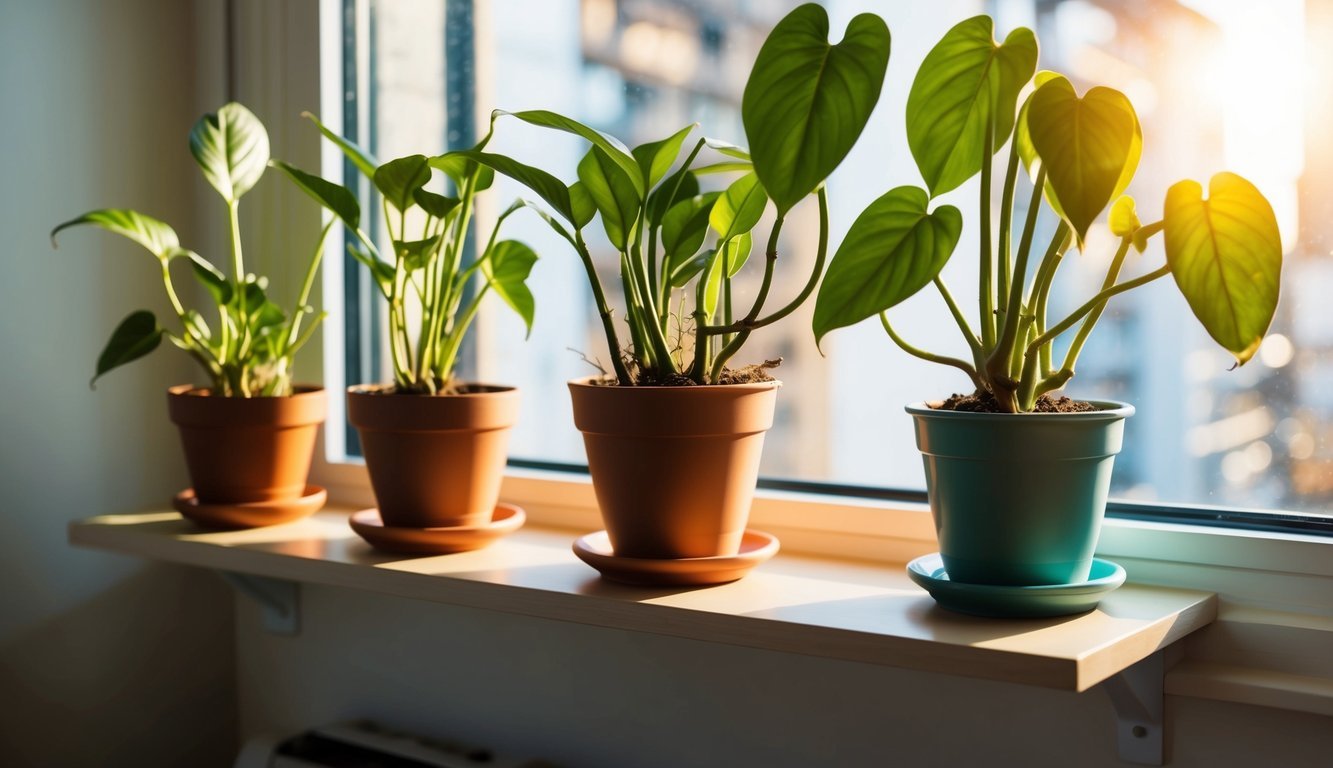I know how hectic life can be, and sometimes, keeping up with plants feels like just another task on the to-do list. Finding low-maintenance plants that thrive with minimal attention can bring a touch of nature into my space without overwhelming my busy schedule. These plants offer a convenient solution for anyone looking to enjoy greenery without the daily commitment.

Whether I’m looking to spruce up my home or garden, it’s essential to choose plants that don’t require constant care.
They not only brighten my environment but also fit seamlessly into my lifestyle, making it easier to embrace my love for gardening without the stress.
Snake Plant
I love having a snake plant, also known as mother-in-law’s tongue, in my home.
It’s one of the easiest houseplants to care for.
The upright, striking leaves add a touch of greenery without demanding much attention.
Snake plants thrive in various light conditions, from low to bright indirect light.
I’ve noticed they do well even when I forget to water them for weeks.
These plants are pretty forgiving!
Watering is simple; I let the soil dry out completely between waterings. Too much water can lead to root rot, so it’s best to err on the side of caution.
They also benefit from the occasional dusting of the leaves.
If any pests show up, spraying them with Neem oil usually does the trick.
Snake plants are versatile, fitting well in different spaces, whether it’s the living room or a home office.
With such minimal upkeep, they’re perfect for busy lifestyles like mine.
Plus, they help purify the air, which is a nice bonus!
ZZ Plant
The ZZ Plant, or Zamioculcas zamiifolia, is one of my favorite low-maintenance houseplants.
It has glossy, dark green leaves that bring a little touch of nature indoors.
What I love most is how forgiving it is when it comes to care.
This plant thrives in low light, so it’s perfect for those less sunny spots in my home.
I don’t need to worry about watering it too often; I let the soil dry out completely before giving it a drink, which is usually every 3-4 weeks.
The ZZ Plant is also quite resilient.
It can handle dry spells without any fuss, making it ideal for my busy lifestyle.
Occasionally, I just dust the leaves with a damp cloth to keep them looking fresh, and that’s pretty much it for maintenance.
There’s no need to stress about fertilizers, either.
A light feeding once or twice during the growing season works perfectly.
The ZZ Plant truly is a superstar in my collection, combining beauty and ease of care effortlessly.
3) Peace Lily
I really enjoy having a Peace Lily in my home.
This plant is not only beautiful with its white blooms, but it also requires very little attention.
Watering is straightforward; I check the top inch of the soil.
When it feels dry, I simply give it water.
Using filtered water is best for keeping it healthy.
Peace Lilies thrive in temperatures between 65 to 80°F. I’ve found they appreciate a bit of humidity, which makes them perfect for indoor spaces.
One of the best parts is that they’re forgiving when I forget to care for them.
They’re low-maintenance and can thrive under various conditions, making them great for my busy lifestyle.
I also love that they purify the air, adding a fresh touch to my home while looking fabulous.
Regularly cleaning the leaves helps the plant look its best, and trimming is simple when needed.
4) Spider Plant
When I think about low-maintenance houseplants, the spider plant is always at the top of my list.
These little guys are great for busy lifestyles.
They thrive in a variety of light conditions, which makes them super versatile.
Spider plants don’t need a lot of water.
I usually check the soil, and if it’s dry, I give it a drink.
They can handle some neglect, which is perfect for me.
One thing I love is their air-purifying qualities.
They help improve indoor air quality, making my space feel fresher.
Plus, the unique, spidery look of the leaves adds a nice touch to any room.
I appreciate that they also produce plantlets.
These “spiders” can be propagated easily, so I can share them with friends or add to my collection.
All in all, spider plants are a fun, stress-free addition to my home.
5) Pothos

Pothos is one of my favorite low-maintenance plants.
It’s perfect for anyone with a busy lifestyle, thanks to its minimal care requirements.
These plants thrive in low-light conditions, making them great for offices or darker rooms at home.
I love how they adapt to different environments without fuss.
Watering is simple, too.
I usually wait until the top inch of soil is dry before giving it a drink.
Overwatering can lead to problems, but pothos is pretty forgiving.
With its heart-shaped leaves and trailing vines, pothos brings a touch of natural beauty to any space.
Whether I use it in a hanging basket or on a shelf, it always looks great.
There are several variations, like the Jade pothos, which has a solid green look.
Others have lovely streaks or dots.
Each type adds its own flair to my indoor garden.
Choosing The Right Plant

When picking low-maintenance plants, I like to consider the specific needs of each plant and the environment where it will thrive.
Finding the right balance can make my gardening experience enjoyable and stress-free.
Understanding Plant Needs
Different plants have unique requirements regarding light, water, and soil.
Before choosing, I take a moment to identify a few essential needs.
For instance, some plants, like the Snake Plant, can handle low light but still look vibrant.
Others may prefer bright, indirect light.
I also think about watering habits.
The ZZ Plant only needs to be watered when the soil is completely dry, making it a great choice for my busy schedule.
It’s important to remember that understanding these needs allows me to choose plants that won’t require constant attention.
Matching Plants To Environment
My home environment plays a big role in determining which plants I should select.
I evaluate factors like lighting conditions, temperature, and humidity.
For example, Monstera deliciosa enjoys partial light and can adapt to lower humidity levels, making it suitable for indoor spaces.
Additionally, I consider the placement of each plant.
If I have a bright shelf, I can place Salvia there.
For dimmer corners, Philodendron works wonders.
By matching each plant to its ideal location, I can ensure my greenery thrives with minimal effort.
Care Tips For Low-Maintenance Plants

Taking care of low-maintenance plants can be straightforward and enjoyable.
I’ll share essential tips on watering, light, and soil requirements to help keep your plants thriving with minimal effort.
Watering Schedule
For low-maintenance plants, establishing an effective watering schedule is crucial.
I usually allow the soil to dry out between watering, which helps prevent overwatering—one of the most common pitfalls.
Here’s a simple guide:
- Check the Soil: Stick your finger about an inch into the soil. If it feels dry, it’s time to water.
- Watering Depth: Ensure that water reaches the roots. I find that watering until it drains from the bottom is effective.
- Frequency: This can vary by plant, but most low-maintenance varieties need water every 1-2 weeks.
Adjust based on the humidity and temperature in your home.
Light Requirements
Different plants have different light needs, but many low-maintenance plants prefer indirect sunlight.
I’ve learned that recognizing the right light conditions can significantly impact plant health.
General Tips:
- Identify Light Levels: Bright, indirect light is ideal for plants like the Snake Plant. Others, like the Pothos, can tolerate low light.
- Rotate Plants: I rotate my plants every few weeks to ensure even light exposure. This promotes balanced growth.
- Avoid Direct Sunlight: Many low-maintenance plants can get scorched with too much direct sun. Finding a spot where they receive filtered light works best.
Soil And Potting
Choosing the right soil and pot is key for low-maintenance plant care.
I prefer using well-draining potting mixes that prevent root rot.
Truths to Remember:
- Soil Type: Opt for a potting mix formulated for houseplants. You can also choose a mix with added perlite for better drainage.
- Potting: Ensure pots have drainage holes to let excess water escape. I’ve noticed that this helps prevent soggy roots.
- Repotting: Most low-maintenance plants can stay in the same pot for years. However, I check annually to see if repotting is needed due to growth or soil exhaustion.

